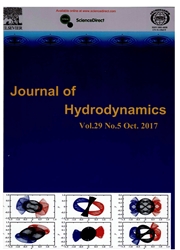

 中文摘要:
中文摘要:
经过在 200 的雷纳兹数字的同轴的强迫的震荡的方形的柱体的流动用内部代码被学习,在浙江大学(CIP-ZJU ) 里开发的命名抑制插值侧面方法。模型用 CIP 方法在笛卡儿的坐标系统被建立到 discretise 海军司烧方程。液体结构相互作用被当作液体的多相的流动,固体分阶段执行同时被解决。一个沉浸的边界方法被用来处理稳固的身体的边界。CFD 模型首先为它的确认经过固定方形的柱体被用于流动的计算。计算然后经过在 streamwise 方向震荡的方形的柱体为流动被执行。可观的注意对在震荡的方形的柱体流的旋涡的对称、反对称的模式被给予醒来。各种各样的摆动振幅和频率被模仿,他们流模式的旋涡上的效果经由不稳定的电梯系数的 Lissajous 模式被分析。在电梯系数, drag 系数和雷达追踪范围之中的关系是也调查的份量上。
 英文摘要:
英文摘要:
The flow past an in-line forced oscillating square cylinder at Reynolds number of 200 is studied using an in-house code, named constrained interpolation profile method developed in Zhejiang University (CIP-ZJU). The model is established in the Cartesian coordinate system using the CIP method to discretise the Navier-Stokes equations. The fluid-structure interaction is treated as a multiphase flow of the liquid and solid phases to be solved simultaneously. An immersed boundary method is used to deal with the boundary of the solid body. The CFD model is first applied to the computation of the flow past a fixed square cylinder for its validation. Computations are then performed for the flow past a square cylinder oscillating in the streamwise direction. Considerable attention is paid to the symmetric and anti-symmetric modes of the vortex shedding in the oscillating square cylinder wake. Various oscillation amplitudes and frequencies are simulated and their effects on the vortex shedding modes are analyzed via Lissajous patterns of the unsteady lift coefficient. The relationship among the lift coefficient, the drag coefficient and the lock-on range is also investigated quantitatively.
 同期刊论文项目
同期刊论文项目
 同项目期刊论文
同项目期刊论文
 Computation of Flow Past an In-Line Oscillating Circular Cylinder and a Stationary Cylinder in Tande
Computation of Flow Past an In-Line Oscillating Circular Cylinder and a Stationary Cylinder in Tande 期刊信息
期刊信息
